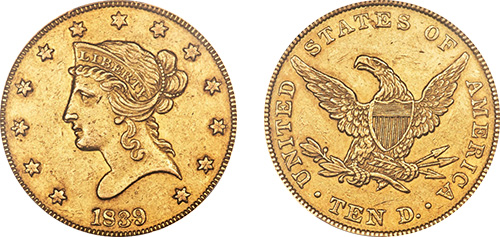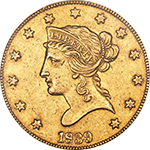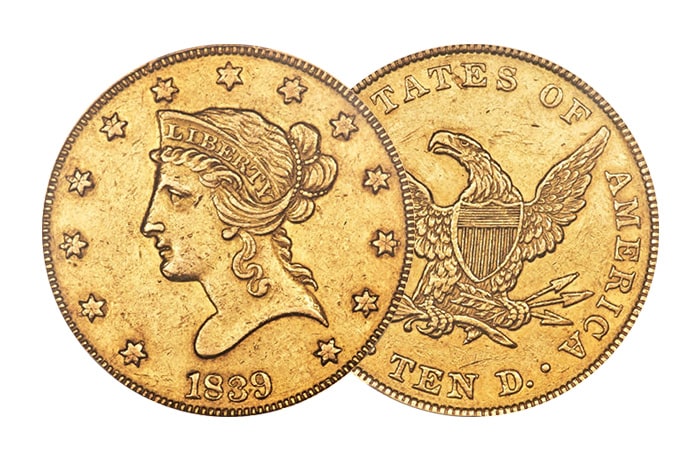The U.S. Mint struck the Liberty Head $10 coin from 1838 until 1907, giving this particular coin a fairly long lifespan in circulation of just about seven decades. The Liberty Head gold eagle is also referred to as the “Coronet” due to the small crown that Lady Liberty wears on the obverse side of the coin. The same design can be found on the Liberty Head half eagle while a similar representation of Liberty can be seen on the 1838 large cent coin.
Due to political upheaval in both Europe and the Americas, gold was scarce in the early 19th century. Thankfully, silver coins, particularly from Latin America, were still bountiful. Hence, Congress settled in a bi-metallic standard to ensure a steady supply of coinage for the new Republic. After two Congressional Acts, the U.S. adjusted the content and fineness of its gold coins in 1838 to keep them in circulation. Consequently, Mint Director Robert M. Patterson was tasked to create eagle coins while Acting Engraver Christian Gobrecht prepared the dies for the new issues.

According to NGC 1, the Liberty Head’s obverse design was inspired by the profile of Venus as depicted in an 1809 painting by Benjamin West called Omnia Vincit Amor (“Love Conquers All”). Both painting and coin design represent the neoclassical style that was in fashion in Europe and the U.S. at the time. Thirteen starts encircle Liberty’s profile while the mint date is located at the bottom below the head. The reverse side of the coin features the heraldic eagle with spread wings, holding an olive branch and a bunch of arrows in its talons. The inscriptions THE UNITED STATES OF AMERICA and TEN D are engraved around the rim. The mintmark, if any, is found between the denomination and the eagle’s feet at the bottom. In 1866, the motto IN GOD WE TRUST was added to a banner above the eagle’s head.
The Liberty Head $10 coin consists of 90% gold and 10% copper.
Philadelphia struck No Motto coins for the entire run of the series. New Orleans minted them from 1841 to 1860, and San Francisco produced Liberty Head eagles from 1854 until 1866. As usual, coins struck in Philadelphia bear no mintmark while those produced in San Francisco and New Orleans features an S and O, respectively. Production of these eagles exceeded 5 million coins, including about 400 proofs. However, few No Motto eagles survived the gold recall of the 1930s, so the coins are scarce in high grades. In fact, every date is rare, which is particularly true in higher grades.
With Motto eagles were exclusively struck in Philadelphia (no mintmark) and San Francisco (S) from 1866 through 1869. Carson City (CC) began producing these coins from 1870 until 1893. New Orleans (O) started minting Liberty Head With Motto coins in 1879 while Denver (D) started striking them in 1906. Mintages remained relatively low over the entire life of the With Motto series, with only 37 dates having six-digit production, and only 10 dates seeing more than one million struck. Proof mintage amounted to a little over 2,000 coins. Due to low mintages and few gold coin collectors at the time, the With Motto Liberty Head eagle is overall very rare these days.
According to the NGC Coin Explorer 2, $10 Liberty Head gold coins nowadays are worth considerably more than the current bullion value of the gold — in even lower grades. As this coin is so rare, its numismatic value is typically much higher than its intrinsic gold value. That renders this coin very coveted in almost any grade, particularly in higher grades. However, as this series is very difficult to complete, it may not be the ideal choice for collectors with a limited budget.
1. http://www.ngccoin.com/coin-explorer/liberty-head-10-pscid-67
2. http://www.ngccoin.com/coin-explorer/liberty-head-10-pscid-67/1880-s-10-ms-coinid-18690


